All profits to

Archive Home Page
Previous Exhibition Following Exhibition
St. Margaret's Hall, Coniston Road, Hatherley, Cheltenham, GL51 3NU
All profits to |  |
Descriptions are based on material supplied by the layout owners
Alstone Servicing Depot Alstone Servicing Depot is a OO gauge layout based in the mid 1980's. Layout dimensions are only 6 feet by 2 feet as I wanted a model railway I could quickly set up and play trains with at home. The track used in standard Peco Streamline, buildings are a mixture of Bachmann and Hornby. The water tower is scratch built and is based on the water tower that stood in Bristol Bath Road depot. Scenery is a mixture of Woodland Scenics, Busch and Penduke models. The layout is based on the Western Region although from time to time locomotives from other regions visit, much like the real Bristol Bath Road was in this era. I chose the 1980's as I have fond childhood memories of days trains spotting with my dad and friends. Speaking of my Dad I would like to thank him for his help and advice while building this layout. |  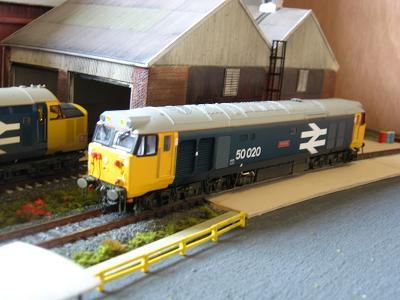 | |
 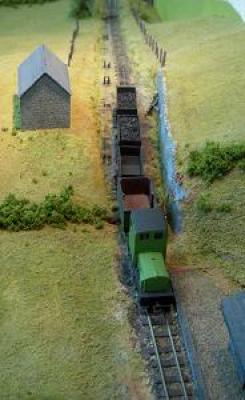 |
This OO9 model is based on Moorewood Colliery and tramway, which was on the southern Mendip coalfield in Somerset. The colliery was sunk in the ten year period between 1860 and 1870, flooded in 1873. Re-opened about 1909 with the tramway constructed in 1913-14. This line led to Moorewood sidings on the Somerset & Dorset Railway, where nearby quarried stone was already being loaded. The tramway closed sometime between 1925 and 1930, with the colliery closing in 1932. My model is made of mainly secondhand materials, from baseboard framing to rails. The scenic areas are supported on pieces of corrugated card, crumpled a bit and glued down. Old newspapers form the detail undulations and make a good surface to glue scenic materials. Rail is soldered construction, from OO gauge components, the points being of pivoted operation. All points and uncoupler controls are manual, wire in tube or bicycle spokes. Much of the rolling stock is altered N gauge, although some new secondhand items are being used. The layout is self supporting with painted sheet board frontage, not curtains. Three spotlights mounted on timber posts are used. The model itself is fairly open in appearance with few cameos and little clutter. The backscenes are painted to represent the typical sky of the area. Moorewood Colliery provides the main interest, with working pit wheel, a visible machine wheel in the winding house and the powered incline. We always try to operate in hands off mode especially with coal wagons using the incline. | |
Blaendare Road Blaendare Road is a fictitious small terminus in Mid Wales, North of Brecon, the layout is set in the 1950's and 1960's. The branch serves a Creamery built by the Milk Marketing Board in the late 1940's. This facility saved the branch from closure in the early years of British Railways. Goods services are provided in the yard with additional traffic generated by a Seed and Feed Merchants and a Coal Merchants yard in this mainly farming area. The station enjoys frequent passenger services from Brecon, Neath, Hereford and Newport. The track is Peco code 100 and points operated by a Seep point motors. The track is ballasted with Woodland Scenics medium ballast. All buildings are kits or modified kits. Rolling stock is mainly ready to run with a few kit built locomotives and wagons. Uncoupling ramps are mixture of Seep and homemade. |  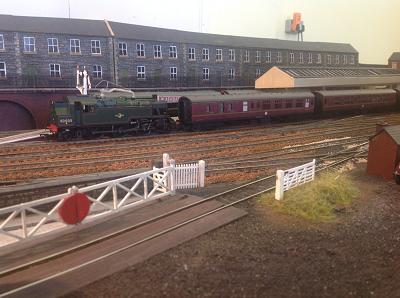 | |
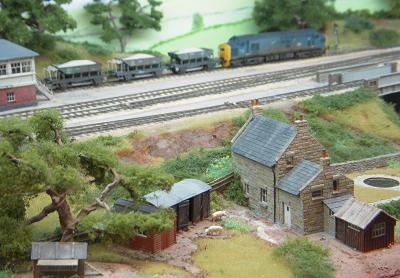 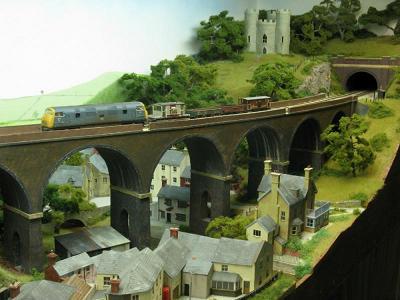 |
About five years ago I decided to sell all of my existing model railway equipment and start again in the smaller scale of N gauge. This was mainly in order to make better use of the space that I had available at home. I wanted to run longer trains and also be able to watch trains passing each other.
Blue Ball Summit is the result of this decision to change. The layout is intended to represent a section of mainline railway somewhere in Devon during the 1970's and early 1980's, probably through rose tinted spectacles. The location itself is entirely fictitious although nearly all the buildings and structures are based on real ones and have been scratch built from plastic sheet. | |
Burford GWR This is a fictional GWR Cotswold branch terminus typical of that area. It is pictured as it might have been in the late 1930's.
What makes this apparently typical model branch terminus different, even rare, is its scale of 3.5mm to the foot, 1/87 scale. Most items on the layout have therefore had to be scratch or kit built. Peco code 75 track is used and has replaced the previous track which dated from just after World War Two. The layout as a whole was initially built in the 1930's and was well ahead of its time then. Baseboards are original old wood of two by one frames supported largely on trestles. Two of the boards do have integral legs. Coupling are 4mm DG items which are operated magnetically. The signals are over 50 years old, and are operated by the wire in tube method. Control is analogue and points are operated by more modern SEEP point motors. | 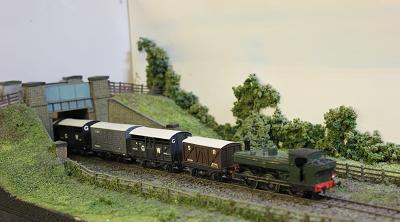  | |
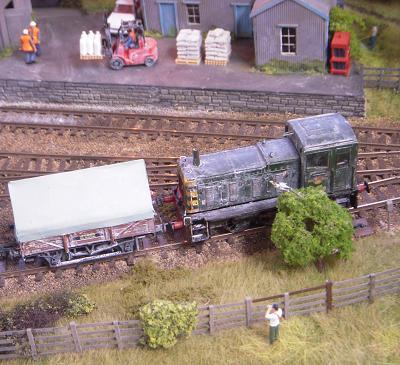 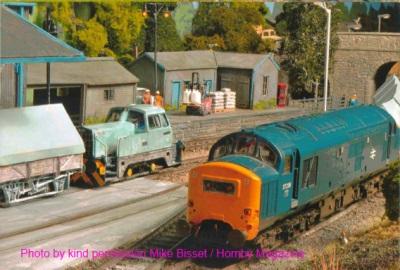 |
Caradon Junction model railway is based on Coombe Junction on the Liskeard to Looe branch in Cornwall. The trains descend a 1 in 40 incline to the junction where passenger trains run into a dedicated small platform. From here they reverse and proceed back through the junction taking the branch line down to Looe, only a small section is modelled but I hope it gives the flavour.
Freight trains, which due to the incline are quite short, are mainly made up of the distinctive china clay hoods. They proceed on a separate track and under the bridge to the clay driers at Moorswater. In reality the driers are much further away than on the model and are generic rather than a copy of those at Moorswater.
The time modelled is in the period around the mid 1970's and early 1980's when blue diesels ruled supreme. Locomotives are represented by class 25, 37 and 52 Westerns. Passenger trains are operated by class 121 "Bubble cars" and all are DCC controlled with sound. The majority of the buildings are scratch built | |
Gunpoint Gunpoint is an imaginary freight yard servicing a mixture of industries, the location of which could be anywhere in the United States of America. This is deliberate as it allows a variety of locomotives from different Railroad Companies in the yard, motive power and rolling stock from the East or West Coast can be seen at Gunpoint. The time period is also flexible, allowing a greater variety of stock to be run on the layout. Construction of the model railway is conventional, utilising a timber framing with a plywood top and folding integral legs. The track is Peco code 100 laid on a cork base and then ballasted. The switches (points) are controlled by Seep motors which are conventionally wired and situated under the baseboard. The trackwork itself is wired for DCC operation and we use Digitrax controllers, which allows the use of sound locomotives if we so wish. Most of the buildings are kits from a variety of manufacturers, but a number have been altered or kit bashed. Ground cover and ballast is mainly from the Woodland Scenics range. | 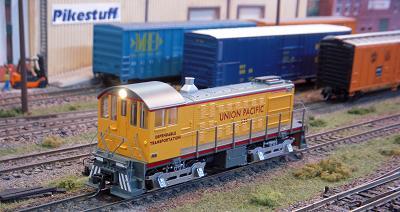 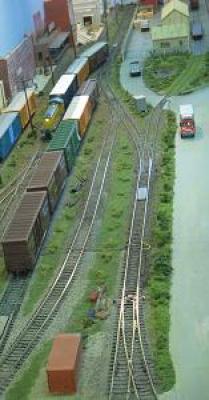 | |
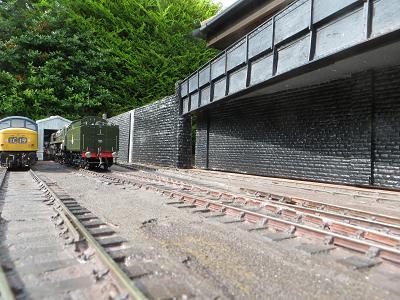  |
Isbury Road is an excuse for showing off my collection of 'O' gauge engines. The layout loosely represents a former steam engine depot that has been modernised for Diesel engine use but has somehow, through the years retained its turntable, for which todays steam engine charter business is very grateful. Heritage steam locomotives regularly use the depot, for turning, refuelling and watering, after visiting the nearby city terminus station. You can expect to see frequent movements on and off the depot of various classes of diesels, mixed in with them, visiting steam engines waiting to use the turntable, watering and fuel facility. The geographical location of this depot is quite difficult to find as it is "Somewhere over the Rainbow" in "La La Land" Operation is by DCC with sound. Peco track is used and all buildings and structures are scratch built. Except the turntable which I built from a Midland Railway Centre kit. | |
Old Time Brickworks My layout the Old Time Brickworks features a narrow gauge railway serving a brick manufacturing plant. It is entirely fictional, set somewhere in England. It has been inspired by several real life brickworks that were served by a narrow gauge railway. Examples are Bursleden in Hampshire and the Old Kiln Light Railway in Surrey. The setting is almost timeless, but the vehicles date it to around the 1960s and 1970s. The Fiction behind the layout is that a group of enthusiasts have taken over a derelict brickworks and are resuming production for the specialist heritage market. They have also restored the narrow gauge railway, they now use a variety of small diesel locomotives. The main manufacturing building needs some more repairs and the site still has a slightly unkempt look about it but this is in keeping with the early days of the restoration in many narrow gauge railways. The Facts about this layout are that the main building which gives the model its name is a Playcraft kit (B805) this was bought in the 1960's and was found in an attic nearly 40 years later. The Round and the Beehive Kilns are from an American company called Model Rail Stuff, they were bought about 15 years ago.
It is designed to be simple, featuring only one track, being relaid in 2018, a continuous loop operable in either direction, with two sidings within the loop and one outside, which has a reverse head shunt. The track is mostly Peco N gauge Setrack, hidden beneath much ballasting. Motive power is mostly provided by new Minitrains diesels and the wagons are Roco, with a Liliput bogie van usually stabled next to a small goods shed. Occasionally coal wagons arrive to provide fuel for the brickworks and there may sometimes be a special excursion passenger train. The stacks of bricks and pallets come from a variety of sources, as do the road vehicles. The layout was first exhibited in October 2012 at the M5-M50 Narrow Gauge Modelers Open day at Corse as a work in progress, a photograph of this appeared in the OO9 news. The scenery has since been improved and in January 2014 it was exhibited at the SWOONS Open day in Weston. The assistance of former fellow group member, Harvey Faulkner-Aston with the scenery is much appreciated | 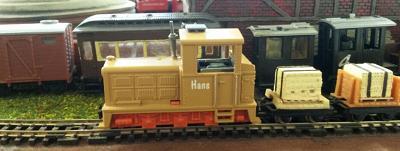  | |
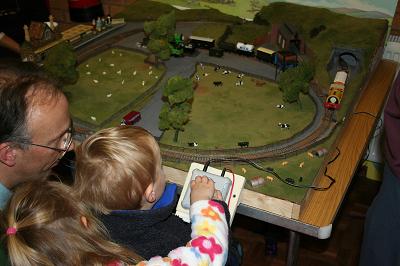 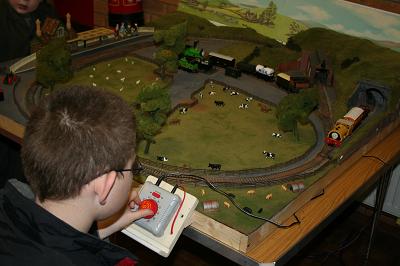 |
We would like to thank Trevor Hallam for looking after the Thomas Layout for many years at our exhibitions and also for refurbishing it at his expense. Unfortunately because of ill health Trevor is no longer able to continue so it was decided to offer Thomas free of charge to Hucclecote Railway Modellers on condition they bring it to all of our future exhibitions. This is the model railway where Children can become Engine Drivers on the Island of Sodor and has of course been inspired by the Reverend Audrey books. Our Thomas and Friends layout has been built for ten years now and in that time we hope it has encouraged many new railway enthusiasts to build a train set of their own. Originally it was intended as a space filler at shows so needed to be small, easy to transport and have a simple track plan, easy for small children to operate. After its first appearance it was clear this model railway would have to be included at all our exhibitions. It incorporates a tunnel, station, level crossing together with locomotive and goods facilities. Train drivers should look out for many of the popular characters; Henry, Percy, Toby, Cranky, the Troublesome Trucks, not forgetting the Sir Topham Hatt better known as the Fat Controller. The famous anthropomorphised rolling stock is mostly from the Thomas range and we are sure most of the adults and all the kids will love it. Happy Driving, but please observe the track speed limits. | |
Wood Street WEBSITE Wood Street is a minimum space industrial layout inspired by typical urban shunting yards that could be found in many towns and cities in England. The time frame is deliberately flexible to facilitate the use of different members stock. A variety of small tank engines and diesel shunters can usually be seen in operation on the layout, together with a wide selection of rolling stock. Structures and buildings are largely freelance although the layout Wood Street is partly derived from a road in the Old Town area of Swindon, which had rail access until the early 1970s. Trackwork on the layout, including the four points, are all Peco. No automated coupling system is used - instead shunting is reliant upon manual coupling of traditional 3-links. | 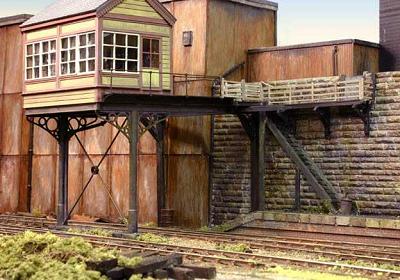 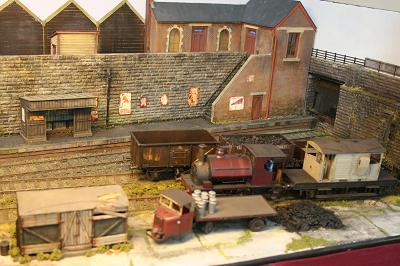 | |
| Displays | ||
Mini scenes | To tbe manor burnt | |
Flying Colours WEBSITE | Abbotswood - the back room story | |
Southdown bus garage on the south coast | Layby featuring fairground transport | |
Gloucester Park | ||
| Modelling Demonstrations | ||
| Andi Dell | Mark Begley | |
| Steve Harrod | Trevor Hale | |
| Trade | ||
| Cheltenham Model Centre WEBSITE | RCSW (Pre-owned) Models, Clive Reid | |
| Rly books, timetables, photos, Stewart Blencowe WEBSITE | ||